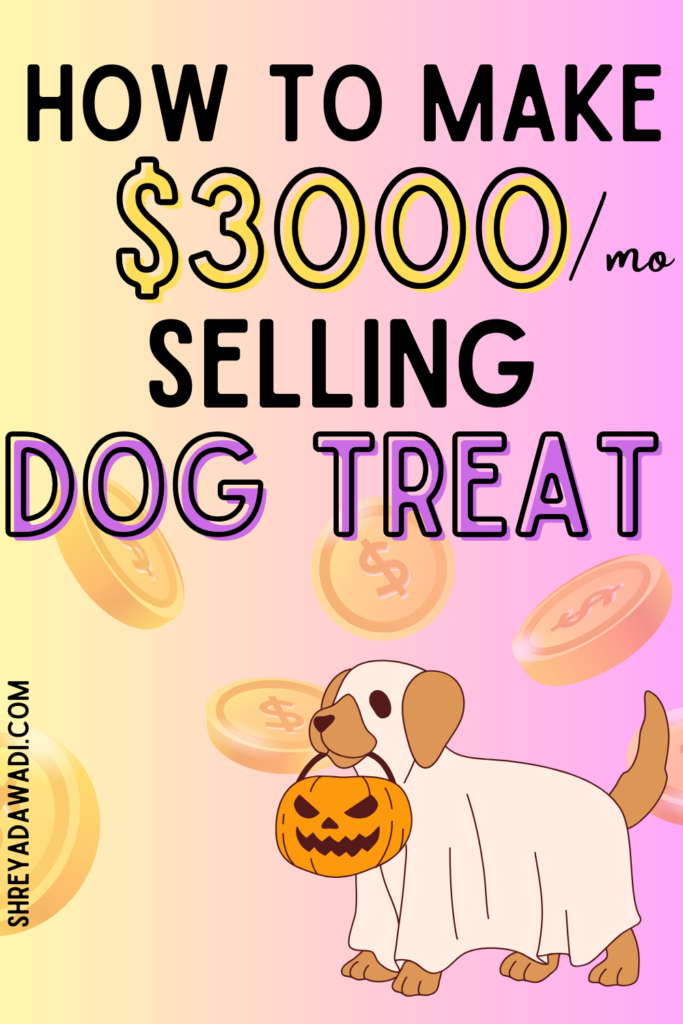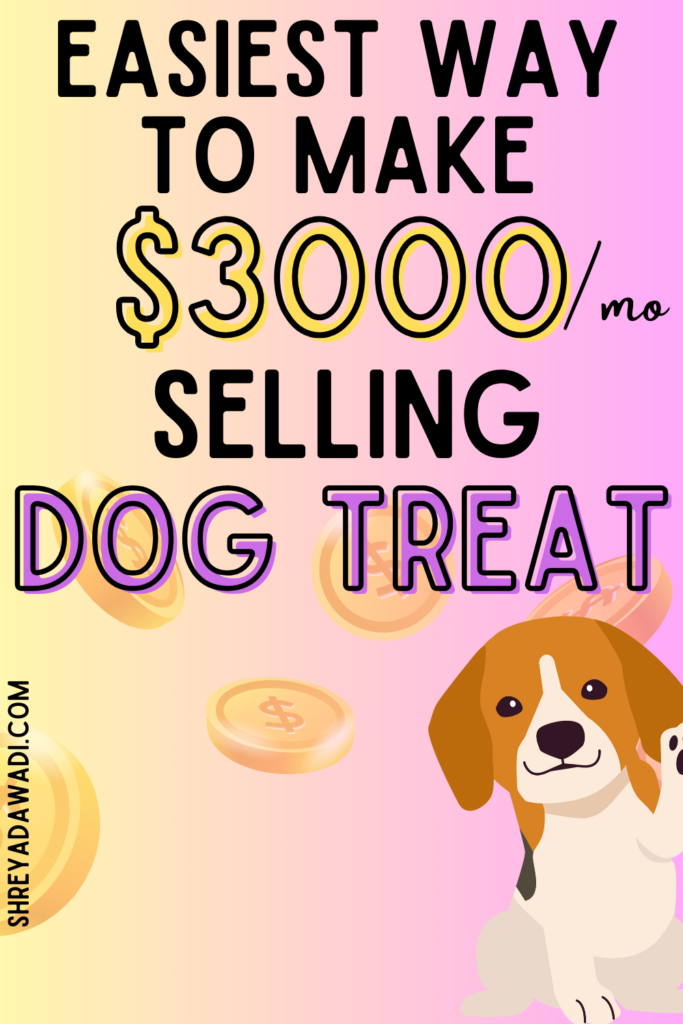Have you ever thought about turning your love for dogs into a profitable business? Learning how to start a dog treat business at home might just be the perfect venture for you. Not only do you get to create delicious treats that dogs adore, but you can also tap into a booming market of pet owners who are always looking for high-quality, homemade options.
In this blog post, I’ll guide you through everything you need to know to get started, from understanding the potential earnings and costs to the best ways to promote your business.
Whether you’re looking to make a little extra cash on the side or build a full-fledged enterprise, these tips and tricks will help you launch a successful dog treat business right from your kitchen. Let’s dive in and explore how you can make this dream a reality!

Can I Make Dog Treats at Home and Sell Them?
Absolutely, you can start a dog treat business right from your own kitchen! When I first considered diving into this venture, I was excited about the idea of combining my love for dogs with entrepreneurship. However, I quickly realized that there were a few important legal considerations and regulations I needed to understand.
Legal Considerations and Regulations
Before you start a dog treat business at home, it’s crucial to check the local regulations in your area. Depending on where you live, there might be specific rules about home food production, especially for pet treats.
I found it helpful to contact my local health department or food safety authority to get clear guidelines. Some areas require you to obtain a food handler’s license or meet certain sanitation standards. Understanding these regulations from the get-go helped me avoid potential pitfalls and ensured I was operating within the law.
Setting Up a Home-Based Dog Treat Business
Setting up a home-based dog treat business involves a few key steps.
First, you’ll need to designate a clean, organized space in your kitchen for baking and packaging. This helps maintain quality and hygiene. I also invested in some essential equipment like mixing bowls, cookie cutters, and baking sheets specifically for dog treats, to keep things streamlined and professional.
Additionally, you’ll need to get your ingredients from reputable sources. Since the health of pets is at stake, using high-quality, safe ingredients is non-negotiable.
I also made sure to label my treats with all the necessary information, including ingredients and expiration dates, to comply with labeling requirements.
Starting a dog treat business from home was a rewarding experience, and taking these initial steps helped set a solid foundation for my business.
How Much Money Can You Make Selling Dog Treats?
When I first decided to start a dog treat business, one of the big questions on my mind was: “How much money can I actually make?” It’s a valid concern, and the potential earnings can be quite promising, depending on a few key factors.
In terms of potential earnings and profit margins, the beauty of starting a dog treat business is that you have a lot of control over your pricing and costs.
Homemade dog treats can sell for anywhere from a few dollars to over $10 per bag, depending on the quality and uniqueness of your product. I found that with the right recipe and branding, my profit margins could be quite healthy.
Several factors will influence your income. First, the quality of your treats plays a huge role. Higher-quality ingredients and unique recipes can justify higher prices. Also, how effectively you market your products will impact your sales volume. Building a strong brand presence and connecting with pet owners through social media or local events can significantly boost your revenue.
Another factor to consider is your overhead costs. Keeping your costs low while maintaining quality is crucial. I found that sourcing ingredients in bulk and investing in efficient baking tools helped me keep expenses manageable and maximize profits.
Overall, starting a dog treat business can be quite lucrative if you’re strategic about your pricing, marketing, and cost management.
Is It Hard to Start a Dog Treat Business?
When I decided to start a dog treat business, I was a bit overwhelmed by the idea of diving into something new.
Honestly, it can be challenging, but it’s definitely manageable with the right approach.
One of the biggest hurdles I faced was understanding and meeting all the regulatory requirements. Each state has its own rules for selling pet food, so doing thorough research and ensuring compliance is crucial.
Another challenge is perfecting recipes that not only taste great to dogs but are also healthy and safe.
It took some trial and error, but investing time in developing quality recipes paid off. You’ll also need to think about packaging and marketing—making your treats stand out in a crowded market requires creativity and effort.

How Much Does It Cost to Start a Dog Treat Business?
The cost to start a dog treat business can vary depending on how big you want to go, but here’s a breakdown of the initial investment and ongoing expenses I encountered. This table should give you a rough idea of what to expect:
| Expense | Estimated Cost |
|---|---|
| Initial Recipe Development | $200 – $500 |
| Quality Ingredients | $300 – $600 |
| Baking Equipment | $150 – $500 |
| Packaging Materials | $100 – $300 |
| Marketing and Branding | $200 – $500 |
| Business Registration | $50 – $200 |
| Insurance | $100 – $300 |
| Website and Online Sales Setup | $100 – $300 |
| Miscellaneous Costs | $100 – $200 |
| Initial Investment Total | $1,100 – $2,400 |
Aside from these initial costs, your ongoing monthly expenses for running a dog treat business will be around $200 – $500 (for ingredients, packaging, and marketing).
These costs can add up, but starting small and scaling gradually can help manage expenses. Planning and budgeting are key to keeping your costs under control while building your dog treat business.
Best Homemade Dog Treat Recipes To Get You Started
When I decided to start a dog treat business, I knew that having a few go-to recipes would be essential. Here are some of the best homemade dog treat recipes that got me started:
- Peanut Butter and Banana Bites: Dogs absolutely love the combination of peanut butter and banana. These treats are easy to make and always a hit.
- Pumpkin Oatmeal Cookies: Pumpkin is great for dogs’ digestion, and these cookies are super simple to bake.
- Sweet Potato Chews: Just slice sweet potatoes thinly and bake them. They turn into chewy, delicious treats that dogs can’t resist.
Creating unique recipes was one of my favorite parts of starting a dog treat business. Here are some tips I picked up along the way:
- Experiment with Ingredients: Don’t be afraid to try different ingredients. Dogs love variety just as much as we do.
- Consider Dietary Needs: Some dogs have allergies or dietary restrictions, so offering grain-free or hypoallergenic options can set you apart.
- Make It Fun: Use cookie cutters in fun shapes or add natural food coloring for a little flair. Presentation can make a big difference.

How Much Do Homemade Dog Treats Sell For?
When I first started my dog treat business, figuring out how much to charge was a bit tricky. Here’s what worked for me:
- Research the Competition: I looked at what other dog treat businesses were charging. This gave me a ballpark figure and helped me understand the market.
- Cost of Ingredients and Time: I made sure to calculate the cost of ingredients and factored in my time. This helped ensure I wasn’t underselling myself.
- Value for Quality: I found that customers were willing to pay more for high-quality, handmade treats. Highlighting the natural and healthy aspects of my treats allowed me to price them higher.
Staying updated on market trends also helped. For instance, there was a growing demand for organic and grain-free treats, which I incorporated into my offerings to stay competitive.
Is Selling Homemade Dog Treats a Good Side Job for You?
Starting a dog treat business was one of the best side jobs I ever took on. Here are some benefits and considerations if you’re thinking about diving in:
Benefits:
- Flexible Schedule: I loved being able to work on my own time. Whether it was baking in the evenings or weekends, it fit perfectly around my other commitments.
- Low Start-Up Costs: Unlike many businesses, starting a dog treat business doesn’t require a huge investment. Basic baking supplies and quality ingredients were all I needed to get going.
- Creative Outlet: It was incredibly satisfying to come up with new recipes and see dogs enjoying my treats.
Considerations:
- Time Management: Balancing this side job with other responsibilities can be challenging. It’s important to stay organized.
- Regulations: There are rules and regulations about selling homemade dog treats, so make sure to check your local laws.
- Marketing Efforts: Success doesn’t come overnight. I had to put in effort to market my business, build a customer base, and maintain quality.
Overall, selling homemade dog treats can be a highly rewarding side job, both financially and personally. If you’re passionate about dogs and enjoy baking, it’s definitely worth considering.
Is Selling Dog Treats Profitable?
When I first decided to start a dog treat business, one of my main concerns was whether it would actually be profitable. From my experience, selling dog treats can indeed be a lucrative venture if you play your cards right. The key is to balance your costs with your selling price while ensuring that your treats stand out in a competitive market.
To analyze profitability and return on investment, I started by calculating all my expenses, including ingredients, packaging, and marketing costs.
Once I had a clear understanding of my total costs, I set a price point for my dog treats that covered these expenses and left room for a healthy profit margin. I also kept track of my sales and adjusted my strategies based on what worked best.
Over time, I found that focusing on quality and unique flavors helped me attract more customers and increase my profits. In the end, my dog treat business not only covered its initial investment but also started generating a steady income.
Where to Sell Your Homemade Dog Treats?
When it comes to selling homemade dog treats, finding the right market is crucial. Here are a few places that worked well for me:
Start by Promoting Your Dog Treats to Family and Friends
The first step I took was to promote my dog treats to family and friends. They were my initial testers and biggest supporters.
Not only did this help me get honest feedback on my products, but it also created a buzz through word of mouth. Friends and family often shared my treats with their networks, helping me reach a wider audience without spending a dime on advertising.
Selling Dog Treats on Etsy
Etsy turned out to be a fantastic platform for selling my dog treats. The site is well-known for handmade and unique items, which made it the perfect place to start a dog treat business. I created a shop, posted high-quality photos of my treats, and wrote detailed descriptions to attract buyers.
Etsy’s reach is enormous, and I soon found myself shipping treats to dog lovers all over the country. Plus, the platform’s built-in audience was already looking for unique products, so it was a great match.
Selling Dog Treats at Farmer’s Markets or Craft Fairs
Another excellent venue for selling homemade dog treats was local farmer’s markets and craft fairs. These events allowed me to interact directly with customers, get immediate feedback, and build a loyal following.
Setting up a booth was relatively inexpensive, and the face-to-face interaction helped establish trust and brand recognition. Plus, the atmosphere at these markets was perfect for showcasing my homemade, high-quality treats.
Register Your Dog Treat Business
When I decided to start a dog treat business, one of the first steps I took was to register my business. This might sound daunting, but it’s a crucial step to ensure everything is legal and above board. Here’s how I did it:
- Choose Your Business Structure: I researched and decided on a sole proprietorship since it was the simplest option for a home-based business. Depending on your plans, you might consider an LLC or another structure.
- Pick a Business Name: More on this in a bit, but picking a name was fun yet challenging. I made sure the name wasn’t already taken by checking with my state’s business registry.
- Register with the State: I filed the necessary paperwork with my state’s business office. This often involves a small fee, but it’s essential to make your business official.
- Get an EIN: I applied for an Employer Identification Number (EIN) through the IRS website. It’s free and only takes a few minutes. This number is necessary for tax purposes and when opening a business bank account.
- Apply for Necessary Permits and Licenses: Depending on where you live, you might need specific permits to sell food products. I checked with my local health department to ensure I had all the necessary licenses.
- Open a Business Bank Account: Keeping my business finances separate from personal ones was important. I opened a business account to manage income and expenses more efficiently.
What Is a Good Name for a Dog Treat Business?
Choosing a name for my dog treat business was one of the most exciting parts of the process. I wanted something catchy, memorable, and reflective of my brand’s personality. Here’s how I approached it:
- Reflect Your Brand: I wanted my business name to convey that my treats were homemade and healthy, so I brainstormed words related to quality, natural ingredients, and happy dogs.
- Keep It Simple: A name that’s easy to remember and spell was crucial. I avoided complicated or lengthy names that people might struggle to recall.
- Check Availability: I made sure the name wasn’t already in use by searching online and checking with my state’s business registry. I also checked domain name availability for a future website.
- Get Feedback: I asked friends, family, and potential customers for their opinions on a few name ideas. Their feedback helped me narrow down the choices.
- Think Long-Term: I considered how the name would look on packaging, business cards, and a website. I wanted something that would grow with my business and still make sense if I expanded my product line.
By following these steps, I was able to register my dog treat business smoothly and choose a name that perfectly represents what I offer. It might seem overwhelming at first, but breaking it down into manageable steps made the process much easier.
Learn about my secret side hustle that made me $2000 per month passively.
What Supplies Do I Need to Start a Dog Bakery Business?
When I decided to start a dog treat business, I realized having the right supplies was crucial. Here’s a rundown of what you’ll need to get your dog bakery business off the ground.
Quality Ingredients
One of the first things I learned is that quality ingredients make all the difference. Dogs deserve treats that are not only tasty but also healthy. I always choose natural, organic ingredients whenever possible. Think whole wheat flour, rolled oats, fresh fruits, and vegetables. Avoid anything with artificial preservatives or additives. Your customers will appreciate knowing they’re giving their furry friends something wholesome and nutritious.
Baking Tools and Supplies
Next, I stocked up on baking tools and supplies. You don’t need a professional kitchen to start, but having the basics is essential. Here’s what I use:
- Mixing Bowls and Measuring Cups: For accurately combining ingredients.
- Baking Sheets and Silicone Mats: To ensure the treats bake evenly and don’t stick.
- Cookie Cutters: Fun shapes can make your treats more appealing.
- Cooling Racks: These help the treats cool down properly after baking.
- Storage Containers: Airtight containers keep the treats fresh and ready for sale.
These items helped me streamline the baking process and produce treats efficiently.
How Long Do Homemade Dog Treats Last?
Once you’ve baked your treats, understanding their shelf life is essential to maintain quality and safety.
Storage and Shelf Life of Homemade Treats
In my experience, homemade dog treats can last quite a while if stored correctly. Generally, they stay fresh for about two weeks at room temperature if kept in an airtight container. If you want to extend their shelf life, consider refrigerating them; this can add another week or two.
For even longer storage, I sometimes freeze my treats. Frozen dog treats can last up to three months and still taste great when thawed. Just make sure they’re well-sealed to prevent freezer burn.
Understanding the shelf life and proper storage of homemade dog treats not only ensures your products remain fresh and delicious but also builds trust with your customers. When I started my dog treat business, these storage tips helped me keep my products top-notch and my furry customers happy.
How to Keep Costs Low When Starting a Dog Treat Business?
When I decided to start a dog treat business, keeping costs low was a top priority. I knew that managing my expenses wisely from the beginning would help me achieve profitability faster. Here are some budget-friendly tips and tricks I used:
- Bulk Buying Ingredients: Purchasing ingredients in bulk not only saved me money but also ensured I had a consistent supply on hand. I found local wholesalers and online suppliers who offered significant discounts for bulk purchases.
- DIY Packaging: Instead of investing in expensive, custom packaging right away, I opted for simple, cost-effective options. I bought plain bags and jars in bulk and personalized them with homemade labels and stickers.
- Utilize Free Resources: I made the most of free online resources to learn and grow my business. There are countless free courses, tutorials, and forums that provide valuable information on everything from baking techniques to marketing strategies.
- Repurpose Kitchen Equipment: Instead of buying new baking tools and equipment, I used what I already had in my kitchen. This helped me avoid unnecessary expenses until my business was more established.
- Barter and Trade: Whenever possible, I traded services with other local businesses. For example, I provided free dog treats to a pet groomer in exchange for promoting my business to their clients.
You won’t believe how easy it was to make $1000 per day with DoorDash. Go ahead and copy my strategy.
How to Promote Your Dog Treat Business?
Effective promotion is key to the success of any business, and my dog treat business was no exception. Here’s how I got the word out and attracted customers:
Create a Social Media Presence
Social media was a game-changer for me. I created accounts on popular platforms like Instagram, Facebook, and Pinterest to showcase my dog treats. I posted regularly, sharing behind-the-scenes looks at my baking process, photos of happy canine customers, and promotional offers. Engaging with followers and joining pet-related groups helped me build a loyal community around my brand.
Ask to Leave Business Cards at Pet Groomers and Vets
One simple yet effective strategy was leaving business cards at local pet groomers and veterinary offices. I approached these businesses with a friendly introduction and a small sample of my treats. Most were happy to support a local entrepreneur and allowed me to leave my cards in their waiting areas.
Volunteer to Help at Events
Volunteering at local pet events was another great way to promote my business. I offered to provide free treats at dog shows, adoption events, and pet fairs. Not only did this give me exposure to a large audience of potential customers, but it also allowed me to network with other pet business owners and enthusiasts.
Take Quality Photos of Your Dog Treats
High-quality photos made a huge difference in attracting customers online. I invested time in learning basic photography skills and used natural light to take appealing pictures of my treats. These photos were crucial for my social media posts, online listings, and promotional materials. Good visuals helped convey the quality of my products and enticed potential buyers to give them a try.
All in All
Starting a dog treat business was one of the most rewarding experiences of my entrepreneurial journey. By keeping costs low and effectively promoting my treats, I was able to turn my passion for dogs into a profitable venture.
If you’re considering starting your own dog treat business, remember that a little creativity and resourcefulness can go a long way. Stay committed, keep learning, and don’t be afraid to reach out and connect with your community. With dedication and the right strategies, you can turn your love for dogs into a thriving business. Best of luck on your journey!
